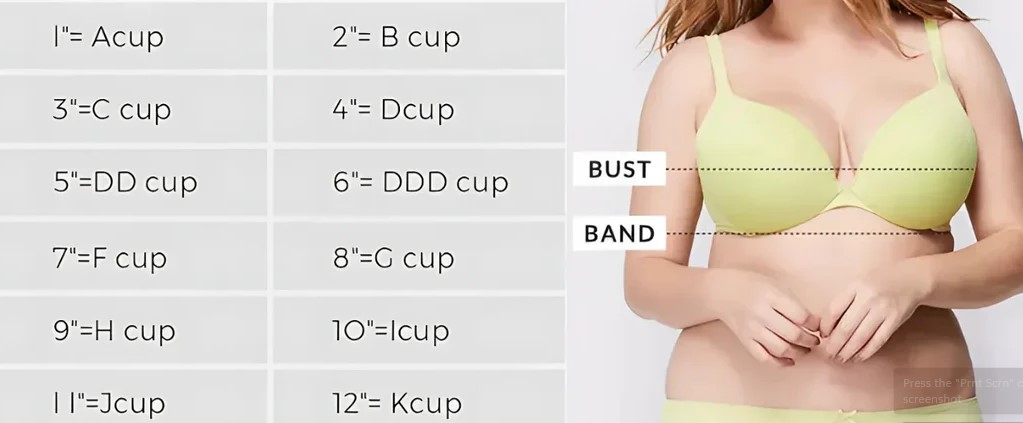
Finding the perfect bra can feel like solving a puzzle that never quite fits together—literally. You try on a dozen bras in your usual size, but none seem to provide the support, comfort, or shape you’re looking for. That’s when many people realize the issue might not be the bra itself—it’s the sizing. If you’ve ever been confused about cup sizes or unsure about what all those numbers and letters mean, you’re not alone. Understanding a breast cup size chart can change the game completely.
In this guide, I’ll break down how cup sizes actually work, why they vary so much between brands, and how to accurately use a cup size chart to finally find bras that truly fit your body and your life.
Why Most People Are Wearing the Wrong Bra Size
Let’s start with a fact that surprises many: Over 80% of people are wearing the wrong bra size. That’s a huge number, and the root of the problem often lies in misunderstanding both band and cup measurements. Most of us pick a size based on what “seems” right, what we’ve always worn, or what fits well enough—not necessarily what is actually accurate.
If you’ve experienced slipping straps, gaping cups, or digging bands, it’s time to take a closer look at a proper breast cup size chart.
What Is a Breast Cup Size Chart?
A breast cup size chart is a reference table that matches your band size (the number) and bust measurement (the fullest part of your chest) to determine your correct cup size. While band sizes like 32, 34, 36, etc., are pretty straightforward, cup sizes (A, B, C, D, and beyond) are where things often go sideways.
The chart essentially calculates the difference between your band measurement and your bust measurement to assign a cup size. For example:
-
A 1-inch difference = A cup
-
A 2-inch difference = B cup
-
A 3-inch difference = C cup
-
And so on…
Sounds simple, right? It is, in theory. But other factors come into play.
Why Bra Sizes Can Vary So Much
Here’s the catch: bra sizing isn’t universal. A 34C in one brand might fit completely differently than a 34C in another. Materials, country of manufacture, stretch, and even the style of the bra itself all play a role.
That’s why it’s important to rely not just on the size tag, but on your own measurements and a well-structured breast cup size chart. Some charts even include international sizing conversions (like UK vs US vs EU sizes), which can be helpful if you’re shopping online from different regions.
How to Measure Yourself for an Accurate Cup Size
Let’s get practical. To make the most of any breast cup size chart, you need two main measurements:
-
Band size – Measure snugly around your ribcage, just under your breasts. Round up to the nearest even number if needed.
-
Bust size – Measure around the fullest part of your chest, making sure the tape is level but not tight.
Once you have both measurements, subtract the band size from your bust size to determine your cup size. For example:
-
Band: 34 inches
-
Bust: 37 inches
-
Difference: 3 inches = C cup → Your size is likely 34C
Make sure to do this while wearing a non-padded bra, and re-measure every 6–12 months, especially if your body has changed due to weight shifts, pregnancy, or lifestyle changes.
Understanding Sister Sizes
This is something I wish I knew earlier: sister sizes. These are alternative sizes that have the same cup volume but a different band size. For example:
-
34C, 32D, and 36B are all sister sizes.
If your usual size feels a bit too tight or loose in the band, try moving up or down a sister size. It can make a world of difference in fit and comfort without sacrificing cup volume.
Choosing the Right Bra Based on Cup Size
Once you know your correct size using a breast cup size chart, the next step is choosing the right type of bra. Not every style works for every size or shape. Here are a few tips based on cup size range:
-
A–B cups: Bralettes, triangle bras, and lightly padded styles often offer enough support and a natural look.
-
C–D cups: T-shirt bras, underwire styles, and balconettes provide a mix of support and lift.
-
DD and up: Full-coverage bras, minimizers, and high-support sports bras are usually the most comfortable and functional.
Remember, fit is personal. It’s okay to mix styles for different outfits or activities. Your favorite might surprise you.
Common Fit Issues and What They Mean
Using a cup size chart helps, but if your bra still doesn’t feel right, here are some red flags and fixes:
-
Cup gaping: Try a smaller cup or different shape (like a plunge).
-
Cup spillage: Go up a cup size or choose a fuller coverage style.
-
Band riding up: Your band is too big; try a smaller band size.
-
Straps digging in: Your band might be too loose and over-relying on the straps.
Solving these issues starts with proper sizing and knowing your body.
Final Thoughts: Don’t Settle for “Close Enough”
A properly fitting bra can improve your posture, confidence, and overall comfort. Taking the time to measure yourself and consult a breast cup size chart is absolutely worth it. You might be surprised at how much better your clothing fits and how much more confident you feel when your undergarments are doing their job well.
Trust me, once you find your true size, you’ll never go back to guessing.
TL;DR
-
Most people wear the wrong bra size—don’t be one of them.
-
A breast cup size chart helps match your band and bust measurements to the correct cup size.
-
Measuring yourself properly is key. Use a flexible tape measure and follow a step-by-step guide.
-
Understand sister sizes—they can open up new options.
-
Bra style matters. Choose styles suited to your size and needs.
-
A good fit is empowering, and you deserve that daily comfort and confidence.





